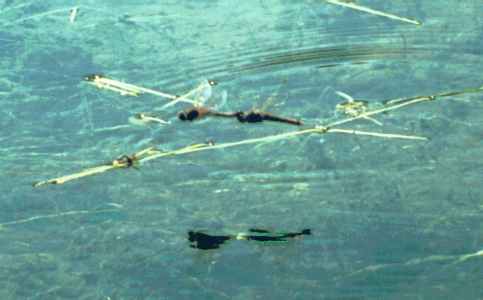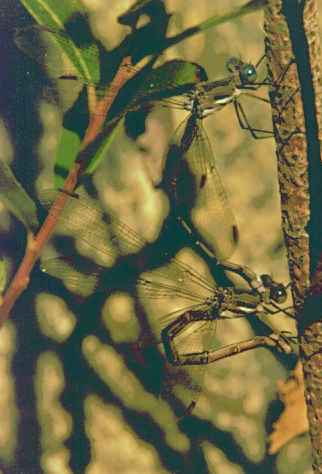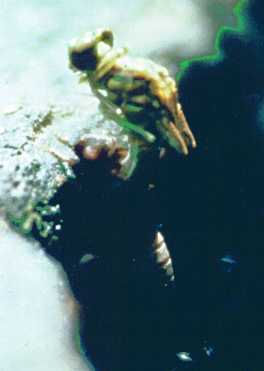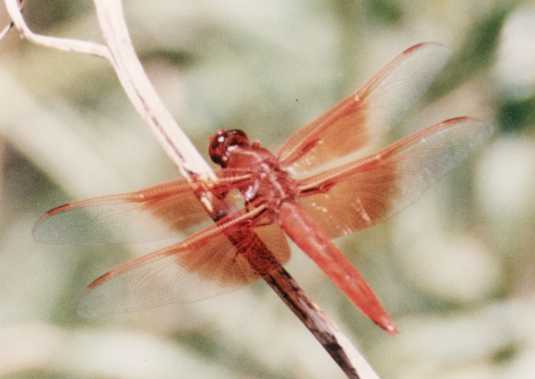Damsels and Dragons - the Insect Order Odonata
The Odonata (from the Greek odon-o meaning tooth), commonly known as
dragonflies and damselflies, is a fascinating insect order. (In some areas, the
term dragonfly is used for both groups.) Since this article is for the Internet
Pond Society, I have emphasized pond species and activities that the reader,
as a pond owner, might observe or perform.
Some of the images used here are linked from other web pages where the reader
will find additional information, pictures or links. All sites were active when
the article was submitted (Jan 31, 1997). Unless otherwise indicated all photographs
are by the author (
details on the reproduction techniques and use restrictions)
Introduction
Dragonflies and damselflies are insects. As such, they have 3 prominent
body parts - a head, a thorax to which the wings, in this case 4, and 6 legs
are attached, and an abdomen. Their front and rear wings are not linked together,
but can be operated independently. The dragonfly is an impressive insect, a
master of the air, daring enough, in some cases, to hover almost within arm's reach
in front of human invaders in its territory. At rest, its wings lie flat, at right
angles to the body. The damselfly is generally much less impressive or conspicuous.
It tends to be smaller and less robust, a much weaker flyer still capable of aerial
acrobatics, but less active. At rest, damselflies hold their wings over their backs,
either together or spread out in a v-shape. Damselflies usually stay close to a surface,
while dragonflies can zoom up into the air and out of sight. Dragonflies and
damselflies are predators throughout their lives.
Dragonflies and damselflies have been around for a long time. Impressive
fossils of dragonflies with 27" wingspans have been found dating back over 200 million
years. Today, the largest ones have wingspans about 5 to 6 inches.
As with many insects, dragonflies have played a significant role in
some cultures. An article by Montgomery in 1972 lists 95 English terms used
for dragonflies. With the current interest in topical postage stamps,
there are now over
100 stamps from around the world that feature dragonflies either as the main
design or a decorative addition.
Among the Odonata there is an amazing amount of variation, both in their life
histories and their activities. These fascinating insects which fly around
your pond for a short period are much older than you might think. Most of them
have spent a much longer period of time as important aquatic predators.
Mating
Appendages that can be seen at the end of abdomen of the male are designed to lock
into species-specific grooves and notches on the female in order to secure the two
together for mating. The features on female dragonflies may be on the head alone
or on the head and the front segment of the thorax. Female damselflies have features
on the front segment of the thorax. Male and female dragonflies tend to wed in the air,
sometimes with an audible impact. Damselflies become hitched together more quietly,
often coming together on vegetation. Hitched pairs, particularly damselflies (just
because they are generally more numerous), can often be seen flying about "in tandem"
looking for mating sites.

tandem pair flying over open water (you can see the reflection)
The mating formation is called a wheel. Attached to the male by her head
and/or the front segment of her thorax, the female curls her abdomen under her, reaching
forward with the tip of her abdomen in order to pick up the sperm from the male's second
abdominal segment. From the side, damselfly pairs appear sort of heart-shaped.
Some dragonflies mate in the air, while others alight to mate (this may be the only
time you get a good view of some species). Damselflies usually land to mate. In
species that land, you can often see the legs of the female wrapped around the
abdomen of the male for strain relief and support during mating. The male may assist
the female by moving or curling his abdomen. Previously mated males can be distinguished
if their abdomens have become damaged (dented) from the downward pressure of the females'
legs. For some species, the mating time is very short, only a few seconds. For others,
especially some of the damselflies, it can be up to several hours. (Perhaps this is why,
Martin Peterson
found that they were
once regarded as a symbol of the love goddess, Freya.) Males and females of some
dragonflies can be seen flying "in tandem" after mating, but this activity is more
common among the damselflies.
Inter-specific sexual activity is normally discouraged by the lock-and-key aspect of the
attachment process (it has been reported). Damage incurred from prior mating activity
can allow some inter-specific activity.
Egg Laying
Depending on the species and/or the circumstances, the male may or may not be around
while the female lays her eggs. Males can often be found guarding the female,
chasing off other potential mates so that she can finish laying the eggs fertilized
with his sperm. Some species go to extremes in mate guarding - the
male doesn't release the female, but remains attached until she has laid at least
some eggs. Tandem pairs can often be seen flying slowly among the vegetation, looking for
oviposition sites.
For many species often seen in tandem, the female inserts each egg individually into
some suitable vegetation, from dead wood to reeds, sometimes above the waterline,
sometimes below, sometimes so far below that the males and females descend into the water
breathing via a protective coating of air that gets trapped in the many fine hairs
on their bodies. In cases where the eggs are laid above the waterline, several
situations may occur. Sometimes the eggs are laid over water, and the newly emerged
larva drops in. Sometimes, the vegetation dies and falls into the water, or
becomes submerged after the rains.

Archilestes californica (damselfly) tandem pair laying eggs
In
D. Paulson's copyrighted image available through the University of Michigan,
6 pairs of the damselfly, Argia moesta, are ovipositing. In this case, the
females generally have their abdomens seeking sites in or near the water while the
males are approximately vertical.
In many cases where the female lays her eggs with the male nearby or absent, the female
hovers over a suitable location, descending periodically to dip the tip of her abdomen
into the water and wash the eggs off. The females of some species scatter their
eggs from the air. Females have been known to become confused and attempt to lay eggs
on unsuitable substrates such as oil and windshields.
If you are interested in allowing these creatures some space in your pond, observe
where egg laying is occuring and make some allowance for this when you perform any
maintenance. There may be preferred sites, some of which might include the more
tropical plants in your pond (i.e. the ones you might take inside to overwinter).
Larvae
After the egg has hatched, the larva (also called a nymph or naiad) is a
crytically colored, free living, aquatic predator. Larvae prey mainly on other
aquatic insects, such as mosquito larvae or even other odonate larvae. Larger
larvae may prey on fish fry. In turn, dragonflies are preyed on by a number of
species, including fish and frogs. They may serve as hosts for certain aquatic
mites and avian parasites. Many species live among the aquatic vegetation.
A damselfly larva is characterized by 3 fin-like appendages, called lamellae, at the
end of its abdomen, The lamellae are important for respiration.

damselfly larvae in water (Ohio Dept. of Natural Resources photo.)
(from the
Rivers Online - Darby Creek Site)
Compared to damselfly larvae, dragonfly larvae are broader and less delicate looking.
Dragonfly larvae lack the lamellae of the damselflies, relying on foliations in the
rectal area for respiration.

larva for a dragonfly known as the Green Darner
(from a Texas A & M study by Dr. Ann Kenimer on the Texas Water Resources Institute web site)

dragonfly larvae similar in appearance to those of many pond species
(from Texas A & M study by Dr. Ann Kenimer indicated above)
As with all insects, the larvae undergo a series of molts as they grow and develop.
While some species have relatively short larval development times (1-2 months from
the egg hatching to emergence), most spend at least a year and some much longer
(5 years or more in places where the climate is arduous) as aquatic larvae. Most
will spend at least one winter in your pond and have to suffer through any
maintenance activities you perform. Some may not survive activities such as cleaning
the "mulm" from your pond.
Emergence
Dragonfly and damselfly larvae are aquatic creatures. At the end of the
final larval stage, the nymph climbs out into the air, perhaps onto a stone,
or a plant stalk, or even some algae floating at the surface. Its position
stabilized, the insect splits this last larval skin open along a suture on the back
of the thorax and pulls itself out through this hole. The exact details of extraction
vary with the orientation of the larval skin. Odonate development lacks the familiar
pupal stage (e.g. chrysalis of a butterfly). By the time the larva leaves the water,
an adult, albeit a rather uninflated one, exists inside the skin which is about to
be shed.

a stream species tranforms on a vertical rock face
The empty larval case, called the exuvia, is hidden mainly in the shadow.
The crumpled features on the back of the thorax are the unexpanded wings.
After the insect has extracted itself, a period of time, usually a couple of hours or so,
elapses during which the body and wings expand and cure sufficiently to withstand flight.
Emergence is not an easy process, and the insect is incredibly vulnerable as it
prepares for life in an entirely new medium. Many things can go wrong, and sometimes do.
Weather changes can have disastrous results. Winds and rain can cause irreparable
damage by bringing things into contact with the developing body or wings.
The insects can become dislodged, falling into the water where they can drown
or be eaten. Where suitable emergence sites are limited, larvae can walk over one
another disrupting development. During emergence, the insect can't fly away, and
hence is vulnerable to numerous predators. Emergence requires a lot of energy
and some insects die trying.

this dragonfly (Libellula quadrimaculata) had a very hard emergence
The front wings appear to be undamaged, but the back wing
on the left appears to have gotten folded over and the one
on the right appears to have been broken. The abdomen is
also malformed, having a segment which twists to the left.
(You probably won't see a picture like this in any books.)
The date and time that emergence takes place tends to be species related but can be
affected by recent weather conditions (especially the temperature). The damselflies
I am familiar with tend to emerge in the morning and fly in the early afternoon.
After curing sufficiently (perhaps a bit earlier if it is disturbed), the insect,
now in its more familiar dragonfly or damselfly form, makes its maiden flight, away
from the water. Compared to the mature adults you might be familiar with, insects
which have just completed their emergence lack the vibrant colors (especially
noticeable in the eyes). Their wings have a higher gloss, as though covered with
cellophane/saran wrap and look more fragile. The maiden flight is generally short
(more like a hop) and does not appear strong or well coordinated - the
flight muscles are weak and the thoracic skeleton has not fully hardened. Recently
emerged insects are often snapped up by hungry or nesting birds.
Most of the pond or quiet water species I am familiar with usually emerge on vegetation
in or near the water. If you are lucky, you might see a nymph climbing
out of the water. I usually find them after their transformation has started, usually
long after. Emergence is a treat to watch, but make yourself comfortable, most things
don't happen very quickly. Take pictures if you want, but try not to disturb the insect
for it is tired and vulnerable. Also, take care of yourself, emergence seldom takes
occurs in a convenient place.
You can monitor the production of your pond by collecting the empty larval skins,
or exuviae, on a regular basis. Examine the emergent vegetation and other suitable
substates like sticks and rocks. If you find an exuvia, check that it is empty.
Whitish strands can usually be seen sticking out of the hole through which the
insect got out. These strands are the remains of the old tracheal linings. Check that
the insect has actually left the vegetation - it may just have moved up to
catch more sunlight. Collect these empty skins by gently sliding them up the vegetation,
or prying them off the substrate. Be careful, they are very light and easily carried
away by any breeze. If the wind has been blowing you may find some of the empty skins
in the water, but they can remain attached to the substrate for some time. Sorting these
by appearance will give you an idea how many species are using your pond.
(Remember that there are other kinds of insects that have an aquatic larval stage.)
Record the numbers by date to give yourself an idea of the cycle of emergence.
Probably you will not see some exuviae that are hidden or inaccessible, but
this will give you some indication about what is there.
Maturation
Having emerged from the water and attained its aereal form, the resulting dragonfly
or damselfly spends some time away from the water while it matures sexually.
This period generally ranges from a few days to a couple of weeks, but can be longer
in species that migrate. During this time, the body and wings harden, and the
color becomes more vibrant. The males of some species undergo dramatic color changes
during this period. This is also a period of high mortality. In cooler areas,
individuals may be attracted to the warm surface of asphalt roads and killed or
stunned by passing cars and trucks.
When they return to the water they are ready to mate.
Adult Behaviour
Adult odonata feed mainly on other insects such as small gnats, mosquitoes, black flies,
horse flies, and deer flies. (Many a beleagured north woods hiker has expressed
gratitude and encouragement to feeding dragonflies.) Some even feed on other
dragonflies or damselflies. Most species hunt mainly during the day, but a few species
are crepuscular (evening) hunters. I would not be surprised to find some daytime hunters
regularly around bright lights in the evenings, but I personally don't know of this
happening.
One interesting behavioral aspect that you can observe for dragonflies which perch
regularly is their postures. Dragonflies can adjust their orientation, body position and
wing positions to regulate their body temperature. Sometimes a dragonfly will position
itself so that the tip of the abdomen is pointed at the sun and the wings are
rotated down and tipped forward to shade the thorax. The surface of the body exposed
directly to the sun is thus minimized. When the sun is high in sky, the
dragonfly is almost standing on its head and this extreme position is called
the "obelisk" posture. Why doesn't the dragonfly just move to a shady spot? If the
insect cools too much, it only needs to adjust its wings or body. If it has moved it
will need to move back, and this uses up energy.
Identification
Dragonflies and damselflies have numerous species specific requirements. The ones
around your pond will usually have an aquatic stage that can tolerate the climatic
conditions in your area and pond. There are a number of species that seem to prefer the
acidic water conditions of bogs and fens. A number of species prefer the running water
of streams, or rivers. A number of other species prefer ponds or slowly moving water.
Many of these pond species can be identified from a distance, but it does take lots
of practice. Field guides are available for some areas.

a common pond dragonfly in the southwest U.S., Libellula saturata,
basking in the sun
The species of dragonflies that prefer ponds belong mainly to the family
Libellulidae, often called skimmers in field guides. Many of these are territorial,
hunting from favorite perches along the water. They can be quite active in the
warmer weather. A number of these are brightly colored, the males and females
sometimes looking considerably different. Many have conspicuous color markings on their
wings. The libellulids are among the easiest dragonflies for the beginner to
identify because of their coloration, and their perching habits, often right out in the
open. The males tend to be more noticeable. (General insect guide books
don't always distinguish between males and females in their pictures.)
Dragonflies can be quite tolerant of photographers, but it is generally a waste
of time and energy to attempt to photograph a reluctant individual. One key area
used in identification in the texts is the venation pattern of the wings.
For libellulids, some veins in the rear wing form a characteristic boot-shaped
pattern - toe down. For many non-libellulids, a picture or some idea of the species
dependent appendages on the male may be necessary for a positive identification.
Unarguably the best dragonfly pictures
currently on the web, these scanned dragonflies, while limited in number, can be
used to examine wing venation and color patterns. Look these pictures up.
There are a number of damselfly species that occur around ponds. Being smaller,
these are harder to photograph reliably. The appendages on the male are the
best characterisitics for identification, but the worst to try and photograph.
Many of the species look similar, and may not be separable photographically
without experience or a photographic reference collection. The patterns on the
males and females often differ, so it helps if you can photograph the two together.
Unlike butterflies, there is little color or pattern variation between members of one
species. The bright colors of dead specimens fade quickly unless they are properly
preserved - even then they are not as brilliant as in life.
Conclusions
Dragonflies and damselflies are exciting creatures to study. Use your web pages
to document the activity you observe. Anecdotal information seldom makes it into
the literature, or is difficult to find. Wetlands, even small ones, are an
important component of world around us.
further information and links
Disclaimer
This article is based on published material and personal experience. While I study
dragonflies and damselflies whenever I can, I am an amateur entomologist (i.e. a person
who studies insects) and a photographer, rather than an insect collector.
Errors in presentation or interpretation are mine alone. Feel free to
contact me if you have any
problems with the text (corrections, clarifications, whatever). Thank you.
Ron Lyons (volunteer 1990-1999)
Chula Vista Nature Center, 1000 Gunpowder Point Drive, Chula Vista, CA 91910-1201








